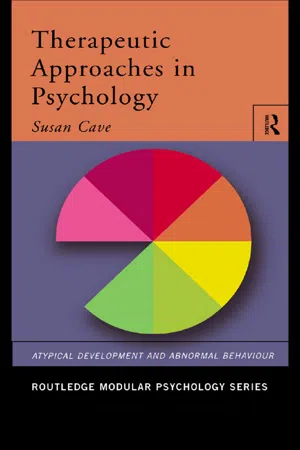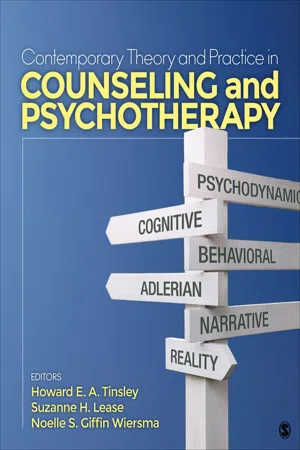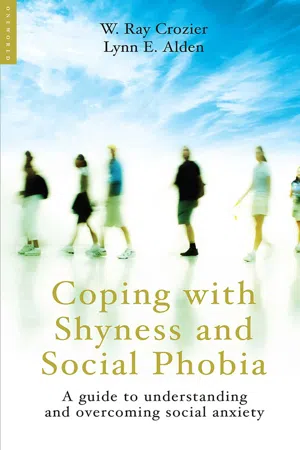Cognitive Therapy
Cognitive therapy is a type of psychotherapy that focuses on identifying and changing negative thought patterns and beliefs. It is based on the idea that our thoughts influence our emotions and behaviors. By challenging and replacing irrational or harmful thoughts with more realistic and positive ones, cognitive therapy aims to alleviate psychological distress and improve overall well-being.
7 Key excerpts on "Cognitive Therapy"
- eBook - ePub
Cognitive Therapy of Anxiety Disorders
A Practice Manual and Conceptual Guide
- Adrian Wells(Author)
- 2013(Publication Date)
- Wiley(Publisher)
...Chapter 3 Cognitive Therapy: BASIC CHARACTERISTICS Cognitive Therapy of anxiety is a time-limited, problem-focused approach to treatment based on the cognitive model of anxiety disorders. Treatment relies on ‘collaborative empiricism’ in which patient and therapist work together with a scientific ethic aimed at treating concrete target problems. Continuous measurement and evaluation of patient problems is used to test hypotheses concerning problem maintenance and to assess treatment efficacy. Mini-experiments in the form of behavioural strategies are employed as a means of socialising patients in a cognitive conceptualisation, and as a means of challenging dysfunctional thoughts and beliefs. Homework is an essential part of treatment and patients are encouraged to undertake specific homework assignments between sessions. Cognitive Therapy is a conceptually driven treatment that proceeds according to the therapist’s case conceptualisation. A wide range of cognitive, interpersonal, and behavioural techniques are used in treatment. Many of the strategies used are familiar techniques of other orientations such as behaviour therapy. However, their use in Cognitive Therapy is not excluded if they can be justified within the cognitive formulation of a disorder. Nevertheless, these procedures are often presented with particular rationales and are modified in ways that maximise cognitive change at the level of beliefs or appraisals. Cognitive Therapy is educational, and new information may be presented didactically, although the preferred mode of delivery is through the socratic dialogue. The socratic method relies on a format of questioning to explore the patient’s understanding and experience and to restructure interpretations and beliefs...
- eBook - ePub
- Sue Cave(Author)
- 2002(Publication Date)
- Routledge(Publisher)
...5 Cognitive and cognitive-behavioural therapies General principles Different therapeutic approaches Applicability and evaluation General principles Theories As early as the 1940s Tolman’s work on learning had suggested that a purely behaviourist view (as described in the previous chapter) was not sufficient because it ignored the contribution of thought processes to learning. Tolman began to talk of ‘purposive behaviour’ and ‘expectations’, both of which terms emphasise the importance of thoughts and perceptions (i.e. cognition) in determining behaviour. For example, a study by Tinkelpaugh (1928) showed that if a monkey that was accustomed to receive a banana as a reward had a piece of lettuce substituted instead while its attention was distracted, it showed unmistakable signs of frustration, appearing to look for the banana and sometimes shrieking at the experimenter. In 1965, Bandura started to develop social learning theory, which emphasised learning by observation and imitation. He also demonstrated that learning could be ‘stored up’ for future use rather than being shown in behaviour immediately (known as latent learning). All of these processes imply that cognition is a crucial factor in learning. Therapies In the sphere of therapy, Rachman and Hodgson (1980) proposed a three systems approach, whereby psychological problems could be seen as having behavioural, cognitive/affective and physiological components. This encouraged researchers to explore areas other than overt behaviour. Cognitive-behavioural therapy (CBT) resembles behaviour therapy with its focus on the present rather than the past. It also makes the general assumption that interaction with the world is carried out via a process of interpretations and inferences about the things that happen to us. These cognitive processes can become distorted, but they are accessible to consciousness and the individual has the power to change them...
- eBook - ePub
Anxiety and Cognition
A Unified Theory
- Michael Eysenck(Author)
- 2014(Publication Date)
- Psychology Press(Publisher)
...Cognitive Therapy or cognitive-behaviour therapy has mostly involved procedures resembling those advocated by Beck and Emery (1985). The rationale for these procedures was described in the following terms by Butler, Fennell, Robson, and Gelder (1991): “anxiety is maintained by anxious thoughts (e.g., about symptoms and about situations that provoke anxiety) and by lack of self-confidence defined as reduced belief in the ability to carry out activities successfully... anxiety can be controlled by learning to recognise anxious thoughts, to seek more realistic and helpful alternatives, and to take action to test these in practice” (p. 169). Durham and Allan (1993) compared Cognitive Therapy against biofeedback, behaviour therapy, relaxation training, and non-directive psychotherapy. They concluded as follows: “On balance, the best results are likely to be obtained by Cognitive Therapy, although the few comparative studies suggest that non-specific factors are important” (p.25). Butler et al. (1991) compared the effectiveness of cognitive-behaviour therapy modelled on the procedures of Beck and Emery (1985) with behaviour therapy based on relaxation, graded exposure, and re-engagement in pleasurable and rewarding activities. Butler et al. (1991) concluded that, “results show a clear advantage for CBT [cognitive-behaviour therapy] over BT [behaviour therapy]. A consistent pattern of change favouring BT was evident in measures of anxiety, depression, and cognition” (p.167). Of particular relevance to the approach adopted in this book, the most significant differences between the two forms of therapy were in the reduction in the perceived likelihood of unpleasant threatening events, and in the reduction in the tendency to interpret ambiguous material in a threatening way. Both of these measures showed greater reduction with cognitive-behaviour therapy than with behaviour therapy...
- eBook - ePub
- David B. Cooper(Author)
- 2016(Publication Date)
- CRC Press(Publisher)
...In the author’s view, the scientist-practitioner model is fundamental to how CBT is defined as a treatment modality. WHAT IS COGNITIVE BEHAVIOURAL THERAPY? KEY POINT 10.1 Cognitive behavioural therapy (CBT) is a structured, problem-solving treatment that has a strong evidence base 19, 20 in the treatment and management of anxiety disorders and depression. Cognitive behavioural therapy is a structured, problem-solving treatment that has a strong evidence base 19, 20 in the treatment and management of anxiety disorders and depression. The clinical focus of CBT is on the individual’s current problems, with the aim of equipping the person with practical skills to tackle problems that interfere with her/his day-to-day functioning. The treatment is goal-orientated, in that goals are agreed between the individual and professional, usually in terms of improving current problems in three domains, namely: 1 practical day-to-day problems 2 intrapersonal problems 3 interpersonal problems. 21 Each step of the CBT assessment and treatment process is explicitly shared with the individual and the foundation of the therapeutic relationship (see Chapter 2) is collaborative empiricism. In this paradigm the individual and professional work together to make psychological sense within a CBT model of what factors are maintaining the person’s problems. This is referred to as a maintenance formulation 22 and is shared with the person as a hypothesis to be tested during treatment. Thus, a central aspect of treatment is the use of what is referred to as behavioural experiments 23 to test out hypotheses in order to collect evidence to validate or refute these hypotheses. The evidence collected is then used to devise further behavioural experiments in order to solve problems and to develop different ways of experiencing self and others and new ways of acting in the world. A word of caution It needs to be acknowledged that there are a many different ‘schools’ of cognitive behavioural therapy...
- Howard E. A. Tinsley, Suzanne H. Lease, Noelle S. Giffin Wiersma(Authors)
- 2015(Publication Date)
- SAGE Publications, Inc(Publisher)
...Based on the premise that the thoughts clients form about events directly affect their feelings, behaviors, and physiological reactions, contemporary CBT approaches vary according to how much emphasis is placed on modifying thoughts versus behaviors. Because most therapeutic approaches use both cognitive and behavioral interventions, this chapter categorizes them all as being CBT. Some authors distinguish between approaches that emphasize cognitive conceptualizations and interventions by referring to them as cognitive therapies (e.g., A. Beck, 2005; Hofmann, Asmundson, & Beck, 2013), as opposed to approaches that emphasize behavioral conceptualization and interventions, which are referred to as cognitive-behavioral therapies (e.g., Barlow, 2002). Aaron T. Beck Aaron T. Beck Regardless of the emphasis, CBT theorists recognize that other theoretical orientations focusing on affect, such as emotion-focused therapy (Greenberg, 2011), or physiology, such as pharmacologic treatments, also are capable of producing meaningful change in clients. However, CBT’s emphasis on identifying and modifying clients’ cognitions or behaviors often produces equally strong or stronger change that occurs more quickly and is more enduring than change produced using other approaches (Dobson et al., 2008; Hollon & Beck, 2013; Hollon, Stewart, & Strunk, 2006; Whitaker, 2010). As a result of the overwhelming empirical evidence in their favor, CBT and interpersonal therapy (Weissman, Markowitz, & Klerman, 2000) are the only two psychosocial interventions that the American Psychiatric Association mandates in the training of psychiatry residents (Weissman et al., 2006). It can be helpful to group CBT theories into meaningful categories in order to better understand them...
- eBook - ePub
- J. Mark G. Williams(Author)
- 2013(Publication Date)
- Routledge(Publisher)
...Cognitive Therapy, through its thought-catching, activity-scheduling and other procedures for reality-testing, provides specific information which will interrupt the mood-affect spiral and provide alternative criteria for reality, so that the hold that mood has on the person is weakened. It does so by facilitating the re-interpretation of past events, by allowing the person to appreciate links between thought, feeling and behaviour through the use of diaries, and by helping the person to generate more effective solutions to their problems. Cognitive Therapy AND THE MECHANISMS OF CHANGE How does this way of thinking about change in psychotherapy relate to the three models I introduced at the outset? It builds upon that of Teasdale (1985) in specifying one way in which the break in reciprocal links between cognition and affect may occur. It is relevant to Brewin (1989), particularly his ideas on the re-categorization of memory, and shows how his theoretical ideas may be anchored in empirical data on autobiographical memory. It builds upon both Brewin and Teasdale’s models by making explicit the role of mood as a criterion of validity and suggests the possibility that therapy works in part by providing alternative criteria, allowing mood to be distrusted as a guide to truth. Third, the model I have suggested is relevant to that of Barber and DeRubeis (1989) (especially as regards problem-solving training as a compensatory strategy). However, I differ in emphasis from them, in that I do not believe that a compensatory strategy such as problem-solving training can be implemented without involving changes in information processing. I suggest that where such training is effective, it is because these strategies begin to enable the person to go beyond the general intermediate descriptions to the specifics of events in their encoding and retrieval of memory...
- eBook - ePub
Coping with Shyness and Social Phobias
A Guide to Understanding and Overcoming Social Anxiety
- Ray Crozier, Lynn E. Alden(Authors)
- 2009(Publication Date)
- Oneworld Publications(Publisher)
...7 Psychological therapy What is cognitive behaviour therapy? As we discussed in chapter 6, the most widely used psychological treatment for social anxiety disorder (SAD) is cognitive behaviour therapy (CBT). In this chapter and in chapter 8 we look at CBT change strategies in greater detail. The primary goal of this approach is to change the factors that maintain social anxiety in the present. CBT places particular emphasis on cognitive processes, that is, the way that socially anxious people think about themselves and social events. With this in mind, we begin our discussion of treatment by examining what we know about how thinking helps to maintain social anxiety. This information, which comes from research and clinical observation, will help us understand how CBT works. The importance of what we think The term cognitive refers to mental activity, or thinking. CBT looks at two aspects of thinking. The first is thought content, that is, what we think about. For example, we can think about pleasant or unpleasant topics; we can think about the past, the present or the future; we can think about ourselves or other people, and so on. Socially anxious people tend to think about topics that maintain their anxiety. Before social events, they may think about past events that did not go well. After social events, they may go over and over what happened and focus on negative aspects of the situation. In CBT, therapists help people reduce the amount of time that they spend thinking about negative topics. CBT also looks at the process of thinking, that is, how we think and the way that we arrive at judgements and conclusions about social events. Arriving at judgements is a complicated process in which the mind has to weigh up different pieces of information. For social events, this includes information about the external situation, such as who is present and how they behave. It also includes information about internal experiences, such as emotional states...






